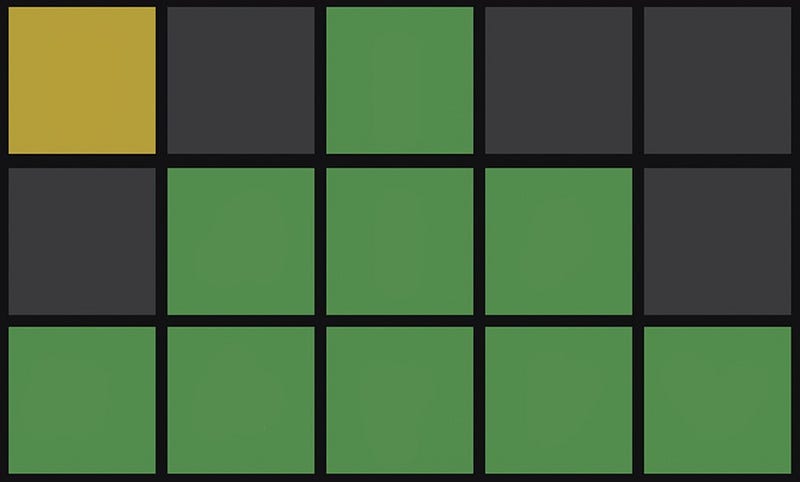Wordle is a well-designed, motivating experience
It’s every game designer’s dream: a game that goes from 90 to 300,000 daily players in less than three months.
Wordle is a simple game: you have six tries to guess a five-letter word. Your first guess is a shot in the dark. But then, for each of the five letters you guessed, you’re told if it’s correct and in the right place (green), correct but in the wrong place (yellow), or just wrong (grey).
This continues for six tries or until you get it. It’s an engaging little game in its own right, if extremely simple. But its thoughtful design choices have made it a viral sensation. If we understand how it motivates people to play and keep playing, we can take that learning and apply it to learning experiences or any other kind of experience.
A great tool for analysing what makes games and experiences tick is Yu-kai Chou’s Octalysis Framework. Based on thousands of hours of gaming, and years of work with gamification clients, Yu-kai has created and refined a framework that divides people’s motivators into eight categories, or core drives.
Wordle is successful by harnessing the power of seven of the core drives, and has an interesting relationship with the eighth. How does it do it, and what could you learn from it?
Space out the commitment you ask of people
Many games want as much of your time as you’re prepared to give. But one of Wordle’s most interesting design decisions is to have a single Wordle available per day. Once you’ve done today’s, you don’t get to play again until tomorrow. If you miss a Wordle, it’s gone forever.
That gives everything a sense of immediacy. You can’t just do it tomorrow. And when a new day starts, you know there’s a new Wordle waiting for you. You never get oversaturated by binging on too many, and you’re always ready for the new one.
It’s a fabulous example of what Octalysis calls the scarcity and impatience core drive. Keep things limited. Don’t sate your audience’s appetite. Keep them wanting more.
Make it clear how well people are doing
Octalysis’ development and accomplishment core drive is the one most often tapped by games. It’s all about giving players a sense of their progress and their wins.
Wordle’s simplicity helps here: you have six tries. If you guess the word in four, that’s good. If you guess it in three, that’s even better. This is all set out in an attractive graphical representation of what you ‘scored’ on each of your tries, as a row of five coloured squares.
It’s not groundbreaking, but it’s simple and appealing. And it sets up the other innovation that’s crucial to its success.
Create an ‘in-crowd’ dynamic that intrigues others
Most app-based games allow you to share your scores. But hit the ‘share’ button on Wordle, and you share that simple representation of your tries: rows of green, yellow and grey coloured boxes.

To Wordle players, it’s trivial to read them as a breakdown of your game progress. You’re in the in-crowd: you know the lingo. To anyone else, it’s an intriguing code. What do those squares mean? Had somebody just shared a simple score with me, I wouldn’t have clicked through. But somebody shared their grid, and I was intrigued. Now I play every day.
It’s a masterclass in tapping the social influence and relatedness core drive, which is at the heart of referrals, recommendations and virality. We love connection, we love to feel related. We’re interested in what others are doing. It also taps the core drive of curiosity and unpredictability. We generally can’t walk past a good mystery.
Want people to draw others into your experience? Think about what exactly they can share, and how, even if your experience isn’t an app. Make it alluring, and make it easy to share.
Make it personal with small touches
That way of showing a score, by means of the coloures squares that show your exact progress, also taps into the core drive of ownership and possession. The score you get isn’t just a number anyone could have: it’s like a fingerprint of your game.
The game does other simple but neat things in a similar vein, like keeping track of your running streak of successful days and average number of tries. Tracking your streak also taps the core drive of loss and avoidance; we don’t want to lose what we’ve earned.
Put constant feedback at the heart of your experience
Feedback is crucial to experiences. Nobody likes going through something wondering whether they’re acing it or fluffing it. And feedback empowers creativity. If you know you did 50% well, you can set yourself to figuring out how to get the other 50% of the way.
Wordle’s core mechanic is excellent on this front. It’s turn-based, with simple feedback: green, yellow or grey for each letter depending on whether it’s right, right but in the wrong place, or wrong.
But that simple feedback after each try, sets your brain running about what possibilities to explore next turn. Got two vowels highlighted yellow? Maybe they’re in second and fourth position, because many five-letter words go consonant, vowel, consonant, vowel, consonant (like the word vowel does).
Experiences that people progress through need thoughtful, consistent feedback that encourages new attempts and new ideas.
Consider whether your experience needs to go big or go small
The Octalysis core drive missing from Wordle is epic meaning and calling. Tapping this core drive is all about linking a game or experience to something bigger, some large purpose or at least a purpose that means something to that person’s life.
Wordle is just a cool distraction. By taking just a few minutes, and limiting itself to one per day, it doesn’t aim to be anything more. It’s a feature, not a bug. It can fit into many people’s lives, and they don’t have to think too much about what it means.
Consider whether your experience needs to represent itself as something big and important, or whether you might be better to aim to be something nice, something little, like a cookie, a special treat for a moment, then forgotten.
Until the next day.

